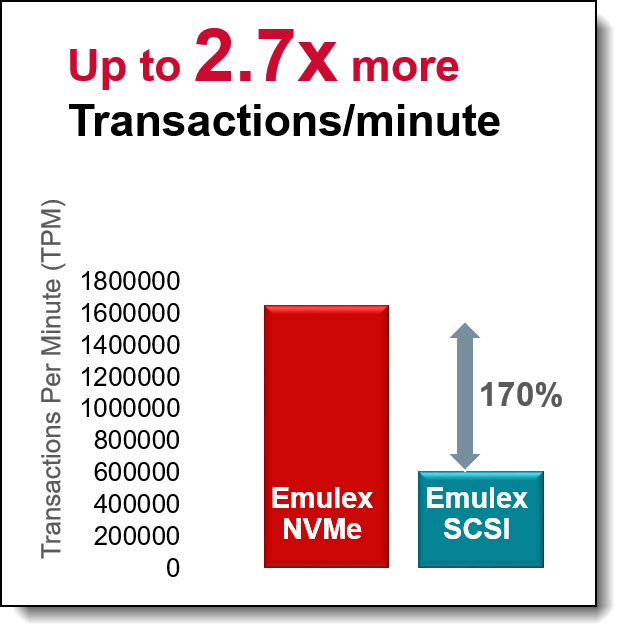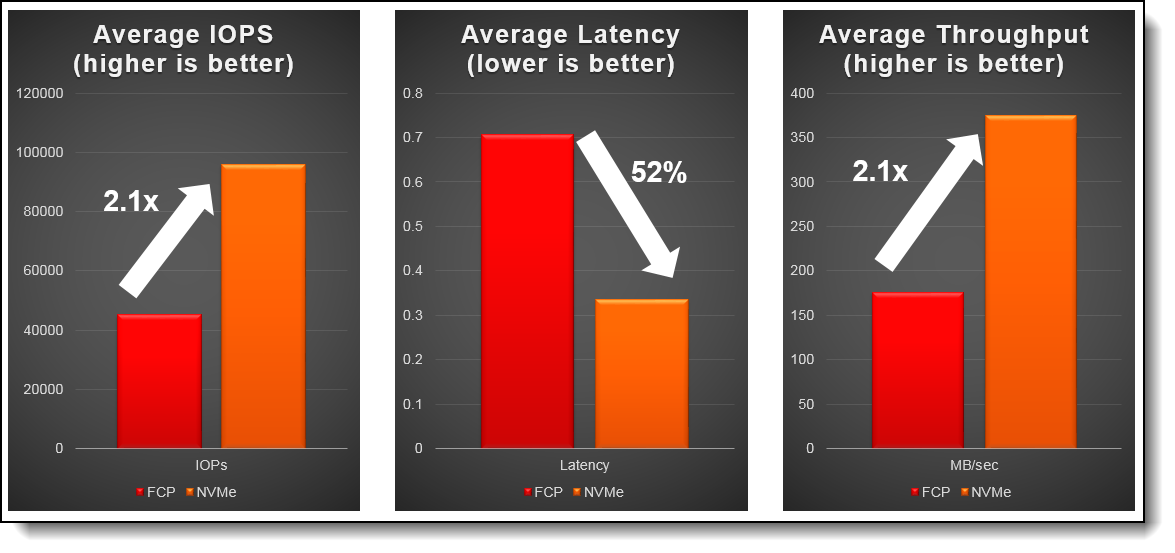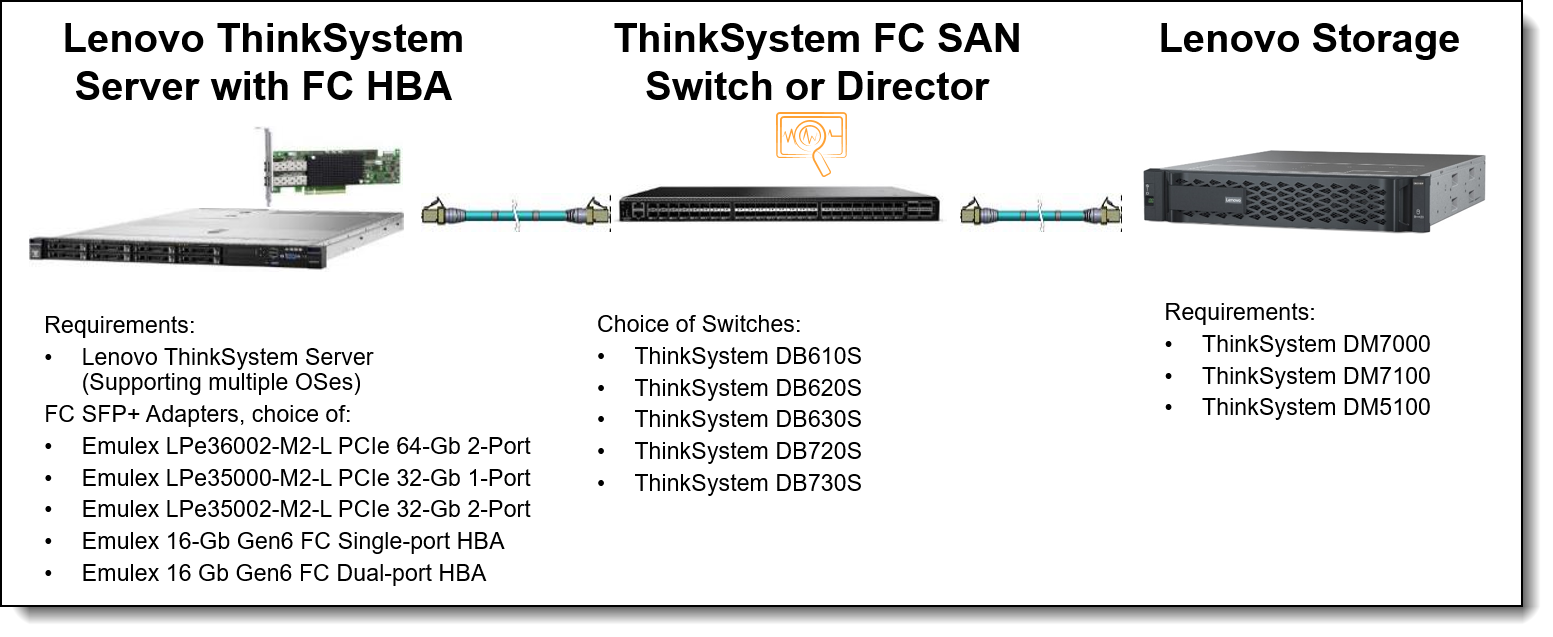Author
- Mike Easterly
Updated
26 Jul 2022Form Number
LP0955PDF size
8 pages, 419 KBAbstract
This paper describes the key components required for building an end-to-end NVMe over FC deployment with Lenovo servers, Lenovo Storage, and Lenovo Fibre Channel networking from Brocade to help solve the bottleneck some businesses may be feeling with their existing storage network. Lenovo is the first in the industry to ship end-to-end NVMe over FC.
Change History
Changes in the July 26, 2022 update:
- Added the latest Lenovo ThinkSystem offerings - Lenovo Solution Components section
- ThinkSystem DB730S FC SAN Switch
Lenovo ThinkSystem End-to-End NVMe over Fibre Channel Solution
Introduction
Fibre Channel is the most trusted and widely deployed purpose-built network infrastructure for storage. Decades of use supporting mission-critical applications have proven that Fibre Channel has the reliability, scalability, and performance to handle evolving, demanding storage applications.
Lenovo can provide end-to-end Fibre Channel solutions that take advantage of new All Flash Arrays (AFAs) that utilize the latest 32/64Gb Fibre Channel technologies and features including Non-Volatile Memory Express over Fibre Channel (NVMe over FC) available with the Lenovo ThinkSystem DM Series All Flash Storage Arrays, ThinkSystem DB Series FC SAN Switches and Directors from Brocade, and Emulex Host Bus Adapters.
Business problem
Data storage is consistently getting faster, delivering improved economics for data centers of all sizes. Flash memory-based storage is a key technology that has significantly increased the performance of storage systems. Solid state disks (SSDs) are now so fast, that the SCSI I/O interface has become the bottleneck.
Solution
The solution is based on a modern storage network capable of adapting to the requirement of NVMe-based arrays. There are critical capabilities that are a requirement to support next-generation flash that every customer needs to keep in mind:
- First, it has to keep running no matter what. With more data moving faster, any slowdowns or disruptions in the network could be catastrophic.
- Next, you need a network that’s designed for flash and ready for NVMe. This means support for low latency, high speed and high bandwidth.
- Then, it needs to scale and be able to adapt to the business. For many enterprises this is petabytes of storage and thousands of servers and storage.
- Finally, it has to be secure to mitigate the risks of breaches. This requires isolation and managed access for peace of mind.
NVMe over Fibre Channel is a solution that is defined by two standards: NVMe-oF and FC-NVMe. NVMe-oF is a specification from the NVM Express organization that is transport agnostic, and FC-NVMe is an INCITS T11 standard. These two standards define how NVMe leverages Fibre Channel. NVMe over Fibre Channel was designed to be backward compatible with the existing Fibre Channel technology, supporting both the traditional SCSI protocol and the new NVMe protocol using the same hardware adapters, Fibre Channel switches, and Enterprise AFAs. There is no need to "rip and replace" the SAN infrastructure with NVMe over Fibre Channel.
An NVMe all-flash array connected to a storage network will help eliminate the bottleneck and deliver more value back to the business. This scalable storage network will deliver reliable flash that performs at the speed of memory.
With this newfound performance:
- Critical applications will accelerate transactions and lead to better user experiences
- Databases will increase the number of queries they support, leading to faster decisions and results
- VM farms will be more efficient with higher VM densities per server, reducing infrastructure costs and simplifying IT
- More types of workloads can be consolidated on hypervisors due to the improved storage performance
Benefits
The benefits of NVMe over FC include the following:
- IOPS: Experience a 2.1x increase in IOPS using a more efficient command by simply moving over to NVMe/FC from the traditional SCSI FCP command set.
- Latency: Achieve 52% lower latency using NVMe over FC. NVMe over FC will have has lower latency than traditional SCSI FCP. Depending on the workload scenario.
- Throughput: Accomplish up to 2.1x throughput improvement over traditional SCSI FCP when using NVMe/FC
- Increased OLTP performance Microsoft SQL Server 2019 for Linux up to up to 2.7x more transactions/minute.
- Increased OLTP performance for Oracle 19c Databases up to 2.6x more transactions/minute and up to 60% better CPU efficiency.
A comparison of performance between Fibre Channel (FCP) and NVMe over FC is shown in the following figure.
The following figure shows the Increased OLTP performance Microsoft SQL Server 2019 for Linux up to up to 2.7x more transactions/minute.

Figure 2. Microsoft SQL Performance (*Emulex ECD Labs tested 9/4/2020, Microsoft SQL 2019 for Linux, RHEL 8.1 NVMe/FC, Lenovo ThinkSystem SR650 with 2x Intel Xeon 8280 Scalable Processors, Emulex LPe35002, Lenovo ThinkSystem DB620S, Lenovo DM7100F, HammerDB TPC-C Transactions per minute. 1:10 mem/dataset ratio, XFS filesystem).
The following figure shows the Increased OLTP performance for Oracle 19c Databases up to 2.6x more transactions/minute and up to 60% better CPU efficiency.

Figure 3. Oracle Performance (*Emulex ECD Labs tested 8/24/2020, Oracle 19c, RHEL 8.1 NVMe/FC, Lenovo ThinkSystem SR650 with 2x Intel Xeon 8280 Scalable Processors, Emulex LPe35002, Lenovo ThinkSystem DB620S, Lenovo DM7100F, HammerDB TPC-C Transactions per minute. 1:10 mem/dataset ratio, 8k XFS, Direct/Async IO).
Deployment Scenarios
NVMe over Fibre Channel can enhance existing SAN workloads. Enterprise applications such as Oracle, SAP, Microsoft SQL Server and others can immediately take advantage of NVMe/FC performance benefits.
NVMe over Fibre Channel can also enable new SAN workload scenarios as well. Big data analytics, Internet of Things (IoT) and AI/deep learning will all benefit from the faster performance and lower latency of NVMe over FC.
Lenovo Solution Components
The Lenovo components in the NVMe over FC solution are as follows.
Additional Information
For more information, see these web resources:
- Video on the Lenovo ThinkSystem End-to-End NVMe over Fibre Channel Solution
https://youtu.be/fwxWGAhXXmY - Infographic on the Lenovo ThinkSystem End-to-End NVMe over Fibre Channel Solution
https://static.lenovo.com/ww/docs/lenovo-thinksystem-dm-series-nvme-infographic.pdf - ThinkSystem DM Series Unified Storage product web page
https://www.lenovo.com/us/en/c/data-center/storage/unified-storage - Lenovo Storage Interoperability Links
https://lenovopress.com/lp0584-lenovo-storage-interoperability-links - Lenovo ThinkSystem DM5100F Unified and DM5100F SAN Flash Storage Array product guide
https://lenovopress.com/lp1365-thinksystem-dm5100f-unified-flash-storage-array - Lenovo ThinkSystem DM7000F Unified Flash Storage Array product guide
https://lenovopress.com/lp0912-lenovo-thinksystem-dm7000f-unified-flash-storage-array - Lenovo ThinkSystem DM7100F Unified All Flash Storage Array product guide
https://lenovopress.com/lp1271-thinksystem-dm7100f-unified-all-flash-storage-array - ThinkSystem DM Series All-Flash Array datasheet
https://lenovopress.com/ds0047-lenovo-dm-series-all-flash-array - Emulex Single and Dual Port 32Gb Fibre Channel Adapters product guide
https://lenovopress.com/lp0692-emulex-32gb-fibre-channel-adapters-for-thinksystem - ThinkSystem SAN Switches product guides
https://lenovopress.com/storage/switches/rack - Emulex NVMe over Fibre Channel User’s Guide
https://docs.broadcom.com/docs/12380302
Trademarks
Lenovo and the Lenovo logo are trademarks or registered trademarks of Lenovo in the United States, other countries, or both. A current list of Lenovo trademarks is available on the Web at https://www.lenovo.com/us/en/legal/copytrade/.
The following terms are trademarks of Lenovo in the United States, other countries, or both:
Lenovo®
ThinkSystem®
The following terms are trademarks of other companies:
Intel® and Xeon® are trademarks of Intel Corporation or its subsidiaries.
Linux® is the trademark of Linus Torvalds in the U.S. and other countries.
Microsoft®, SQL Server®, Windows Server®, and Windows® are trademarks of Microsoft Corporation in the United States, other countries, or both.
TPC® and TPC-C® are trademarks of Transaction Processing Performance Council.
Other company, product, or service names may be trademarks or service marks of others.
Configure and Buy
Full Change History
Changes in the July 26, 2022 update:
- Added the latest Lenovo ThinkSystem offerings - Lenovo Solution Components section
- ThinkSystem DB730S FC SAN Switch
Changes in the August 24, 2021 update:
- Added the latest Lenovo ThinkSystem offerings
- ThinkSystem SR630 V2 and SR650 V2 servers
- ThinkSystem Emulex LPe36002 64Gb 2-port PCIe Fibre Channel Adapter
Changes in the December 27, 2020 update:
- Added the latest Lenovo ThinkSystem offerings
Changes in the July 23, 2019 update:
- Added the Emulex LPe35000 and LPe35002 32GbFC HBAs to the Servers table - Table 1
Changes in the July 2, 2019 update:
- Added the DB630S switch and additional models of the DB620S to the Networking table - Table 2
Changes in the October 24, 2018 update:
- Updated the supported HBAs and operating systems - Table 1
- Updated the part numbers in the Networking table - Table 2
First published: September 13, 2018
Course Detail
Employees Only Content
The content in this document with a is only visible to employees who are logged in. Logon using your Lenovo ITcode and password via Lenovo single-signon (SSO).
The author of the document has determined that this content is classified as Lenovo Internal and should not be normally be made available to people who are not employees or contractors. This includes partners, customers, and competitors. The reasons may vary and you should reach out to the authors of the document for clarification, if needed. Be cautious about sharing this content with others as it may contain sensitive information.
Any visitor to the Lenovo Press web site who is not logged on will not be able to see this employee-only content. This content is excluded from search engine indexes and will not appear in any search results.
For all users, including logged-in employees, this employee-only content does not appear in the PDF version of this document.
This functionality is cookie based. The web site will normally remember your login state between browser sessions, however, if you clear cookies at the end of a session or work in an Incognito/Private browser window, then you will need to log in each time.
If you have any questions about this feature of the Lenovo Press web, please email David Watts at dwatts@lenovo.com.


